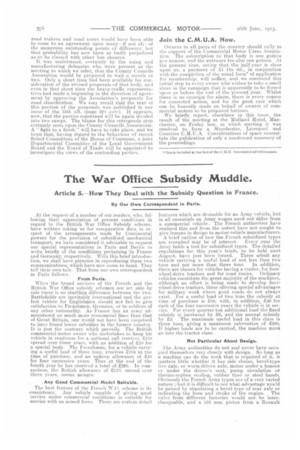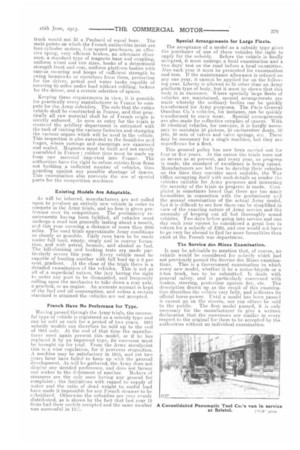The War Office Subsidy Muddle.
Page 2

Page 3

If you've noticed an error in this article please click here to report it so we can fix it.
Article 5. -How They Deal with the Subsidy Question in France.
By Our Own Correspondent in Paris.
At the request of a number of our readers, who, following their appreciation of present conditions in regard to the British War Office Subsidy scheme, have written asking us for comparative data in respect of the arrangements made by Continental powers for the provision of subsidised mechanical transport, we have considered it advisable to request our special representatives in Paris and Berlin to write briefly of the conditions pertaining 'in France and Germany; respectively. With this brief introduction, we shall have pleasure in reproducing these two communications, which have now come to hand. They tell their own tale. That from our own correspondent in Paris follows.
From Paris.
When the broad outtines of the French and the British War Office subsidy schemes are set side by side there is no startling difference between the two. Battlefields are inevitably international and the perfect vehicle for Englishmen should not fail to give satisfaction to Frenchmen. Germans. or to soldiers of any other nationality. As France has an army administered on much more economical lines than that of Great Britain, one would not have been surprised to have found lower subsidies in the former country. It is just the contrary which prevails. The British commercial-Motor ()Weer who undertakes to keep his vehicle in readiness for a national call receives Ell+) spread over three years, with an addition of E10 for a 'special body. The 'Frenchman, for a vehicle carrying a useful load of three tons, receives £104 at the time of purchase, and an upkeep allowance of £48 for four successive years. Thus at the end of the fourth year he has received a total of £298. In comparison, the British allowance of 2110. spread over three years, seems meagre.
, Any Good Commercial Model Suitable. , The best feature of the French W.O. scheme is its consistency. Any vehicle capable of giving good service under commercial conditions is suitable for service with an armed force. There are certain detail features which are desirable for an Army vehicle, but in all essentials an Army wagon need not differ from a commercial vehicle. The French authorities have realized this and from the outset have not sought to give lessons in design to motor-vehicle manufacturers.
A brief outline of how the French subsidized types are recruited may be of interest. Every year the Army holds a test for subsidized types. The detailed regulations for this year's trials, to be hekl next August, have just been issued. These admit any vehicle carrying a useful load of not less than two tons and not more than three tons. In addition, there are classes for vehicles-having a trailer, for four7 wheel-drive tractors and for road trains. Ordinary vehicles constitute the great majority of the machines, although an effort is being made to develop fourwheel-drive tractors, these offering special advantages for military work where good roads do not always exist. For a useful load of two tons the subsidy at time of purchase is g80, with, in addition, 240 for each of the four successive years the vehicle is in service. For every quarter-ton additional load the fixed subsidy is increased by £6, and the annual subsidy
The maximum useful load in this class is three tons, giving a maximum subvention of £203. If higherloads are to be carried, the machine must go into the tractor class.
. Not Particular About Design.
The Array authorities do not and never have occupied themselves very closely with design. So long as a machine can do the work that is required of it, it matters little whether it has side chains, bevel-type live axle, or worm-driven axle, motor under a bonnet or under the driver's seat, pump circulation or thermo-syphon cooling, rubber tires or steel bands. Obviously the French Army types are of. a very varied nature ;,but-iteis -difficult to see what advantage would be gained by stipulating a bevel type of rear axle or indicating the bore and stroke of the engine. The axles from different factories would not.. be interchangeable, and a 100 mm. piston from a Renault
truck would not fit a Panhard of equal bore. The main points on which the French authorities insist are four cylinder motors, feur-speed gearboxes, an effective sprag, very efficient brakes, an adequate clearance, a standard type of magneto base and coupling, uniform wheel and tire sizes, hooks of a determined strength front and rear, uniform platform bodies with canvas covering and hoops of sufficient strength to swing hammocks or stretchers from them, protection for the driver, petrol and water tanks capable of covering 65 miles under load without refilling, lockers for the driver, and a certain selection of spares.
Keeping these requirements in view, it is possible for practically every manufacturer in France to compete for the Army subsidies. The rule that the entire vehicle shall he constructed in France, and that practically all raw material shall be of French origin is strictly enforced. As soon as entry for the trials is received the artillery department is entrusted with the task of visiting the various factories and stamping the various organs which will be used in the vehicle. This inspection is also extended to the foundries and forges, where castings and stampings are examined and sealed. Magnetos must be built and not merely assembled in France ; rubber tires must be made up from raw material imparted into France. The authorities have the right to refuse entries from firms not building a sufficient number of vehicles, thus guarding against any possible shortage of spares. This examination also prevents the use of special parts for the competition machines Existing Models Are Adaptable.
As will be inferred, manufacturers are not called upon to produce an entirely new vehicle in order to compete in the Army trials, and no firm is given preference over its competitors. The preliminary requirements having been fulfilled, all vehicles must undergo a road test generally lasting about a month, and this year covering a distance of more than 2000 miles. The road trials approximate Army conditions as closely as possible. Daily runs have to be made leader full load, empty, Singly and in convoy feruletime and with petrol, benzoic, .and alcohol as fuel. The hill-climbing and braking tests are made par ticularly severe this year. Every vehicle must be capable of hauling another with fell load up a 6 per cent. gradient. At the Close of the trials there is a detailed examination of the vehicles. This is not at all of a .superficial nature, the jury having the right to order any part to be dismantled, and frequently calling upon the mechanics to take down a rear axle, a gearbox, or an engine. An accurate account is kept of the fuel and oil consumption, and unless a ceitain standard is attained the vehicles are not accepted.
French Have No Preference for Type.
Hai ing passed throegit the Army trials, the successful type of vehicle is registered as a subsidy type and can be sold as such for a period of two years. 1913 subsidy models can therefore be sold up to the end of 1915 only. At the end of that time the manufacturer must again present this model, or if he has replaced it by an improved type, its successor must be brought up for trial. From the Army standpoint this is a wise regulation, for it prevents stagnation. A machine may be satisfactory in 1913, and yet two years later have failed to keep up with the general development.. As will be gathered, the Army does not displsy any decided preference, and does not favour one maker to the detriment of another. Makers of steamers are the only ones having any ground for complaint : the limitations with regard to supply of • water and the ratio of dead weight to. useful load have made it impossible for any French steamer to be
subsidized. Otherwise the subsidies are very evenly _2E37 distributed, as is shown by the fact I hat last year 12 films had their models accepted and the same number A Consolidated was successful in 19i1. Special Arrangements for Large Fleets.
The acceptance of a model as a subsidy type gives the purchaser of one of these vehicles the right to apply for the subsidy. Before the vehicle is finally accepted, it must undergo a local examination and a two days' test on the road before a, local committee. Also eaeh'yea.r it must be presented for examination and tests If the maintenance allowance is refused on any one year, it cannot be applied for on the following year. Liberty is allowed to fit other than an Army platform type of body, but it must be shown that this body is in existence. Where specially large fleets of vehicles are maintained, special arrangements are made whereby the ordinary bodies can be quickly transformed for Army purposes. The Paris General Omnibus Co.'s vehicles, for instance, Can be quickly transformed to carry meat. . Special arrangements are also made for eallective supplies of Spares. With 50 identical vehicles, for instance, it is hardly necessary to maintain 50 pistons, 50 carburetter floats, e0 jets, 50 sets of valves and valve springs, etc. These may be necessary for a single machine, but they are superfluous for a fleet. .
This general policy has now been carried out for four or five years. At the outset the trials were not as severe as at present, and every year, as progress is made, the standard of excellence. is being 'raised. Manufacturers are left Free to develop their vehicles on the lines they consider most suitable, the War Office occupying itself with such details as render the vehicles suitable for Army purposes and increasing the severity of the trials as progress is made. Complaint is sometimes heard that there are too many formalities in connection with the preliminary and the annual examination of the actual Army model, but it is difficult to see how these can be simplified in view of the exacting nature of Army service and the necessity of keeping out all but thoroughly sound vehicles. Two days before going into service and one day each year cannot be considered a great loss in return for a subsidy of £296, and one would n•at have to find go very far abroad to far more formalities than exist at the French war departmero.
The Service des Mines Examination.
It may be advisable to mention that, of course' no vehicle would be considered for subsidy which had not previously passed the Service des Mines examinations. This is a Government examination to which every new model, whether it be a motor-bicycle or a 5-ton truck, has to be submitted. It deals with general safety, and is particularly concerned with
brakes, steering, protection against fire, etc. The description drawn up as the result of this examination describes the vehicle very fully, and indicates its official horse-power. Until a model has been passed it cannot go on the streets, nor can others be sold to the public. The first model passed, it is only necessary for the manufacturer to give a written declaration that the successors are similar in every respect to the original fmthem to be accepted by the authorities without an individual examination.
































